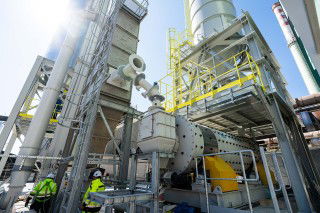This week the Alliance for Low-Carbon Cement and Concrete (ALCCC) published its latest report on 'fast-tracking cement decarbonisation'. The document looks at underperforming and reaching performance-based standards for decarbonisation.
The issue with today's cement industry standards is that they are not designed for a quick entry of low-carbon cement. "Safe and low-carbon solutions already exist but need market access through environmentally ambitious standards and policies," says ALCCC. "Today, cement and concrete standards prevent this from happening. They follow a prescriptive logic that does not allow new materials and innovations to enter the market at a large scale. Shifting to performance-based cement and concrete standards would remove this barrier and create a level-playing field for low-carbon cement and concrete solutions."
Performance-based standards
ALCCC believes that the adoption of performance-driven standards in the sector could cut CO2 emissions by more than 50 per cent in Europe. As clinker substitution can dramatically reduce the sector’s carbon emissions, the targets set for lower clinker levels in cement are decisive for where the bar is set. In Europe clinker substitution targets clinker-to-cement ratio of 74 per cent by 2030 and 65 per cent by 2050. Other markets such as Latin America have higher rates of 66 per cent but with ambitions to lower this to 53 per cent by 2030 and 51 per cent by 2050.
Scaling-up low-carbon cements
Reducing clinker content is only part of the story. Cement producers also need to scale up manufacture of low-carbon cements and concretes. In Europe there are six sets of cement types from CEM I to CEM VI, with a subset of specified mixtures. But there is always a fixed level of Portland clinker, which can be blended with supplementary cementitious materials and additives. Concrete standards (EN 206) are non-harmonised across Europe, allowing individual countries to impose additional requirements for cement used in concrete mixes. Minimum cement content per cubic metre can also be specified, which can mean more cement and clinker is used than is needed.
Tracking decarbonisation progress
Keeping track of progress for decarbonisation at national and company level is becoming essential and while this is in most cases still voluntary, there is a call for tighter monitoring and performance-based industry standards. Many companies are trying to follow industry roadmaps and have formed arrangements with organisations like the First Movers Coalition (FMC) and the Science Based Targets Initiative (SBTi) to accelerate decarbonisation and have their emissions independently verified. At a national and global level, cement associations are guiding members and a fuller picture of where countries are on their decarbonisation road is starting to appear.
UAE – a case study
This week, in the UAE Star Cement (Aditya Birla Group) presented its recommendations to meet decarbonisation targets at the ‘National Dialogue on Climate Ambition’. It reported that all the cement manufacturers still need to review their key performance indicators (KPIs) for power and heat consumption, alternative fuel (AF) and alternative raw material (ARM) usage, and to plan to narrow the industry gaps with Best Available Techniques (BATs). In terms of electrical energy, cement producers can employ waste heat recovery systems and solar renewable energy to reduce electricity consumption by 20-40 per cent while power providers can offer support through synchronisation. Advances need to be made to allow natural gas pricing to be competitive with imported coal for fuel switching. Star Cement estimates this could reduce CO2 by 150kg/t of clinker produced. While SCMs are not readily available in the UAE, cement producers will need to increase Portland limestone cement production for non-bearing structures. Increasing AF and ARM usage depends on a more seamless transfer from source to cement plant with government subsidies. Star Cement recommends that facilities for disposing of bypass dust are increased by 20 per cent. In addition, Star Cement asks that the Ministry of Mines explore the availability of active pozzolana and kaolitic clay for blended cements and calcined clay cements to reduce OPC use.
Summary
ALCCC’s report gives strong support for the benefit that moving to performance-based standards would have in Europe in accelerating decarbonisation. Removing the barriers to decarbonisation for the cement sector is an ongoing requirement. Much of the devices and actions needed to meet decarbonisation goals are visible to cement producers, but more coordinated action will encourage faster decarbonisation and is likely to produce greater momentum for change.
